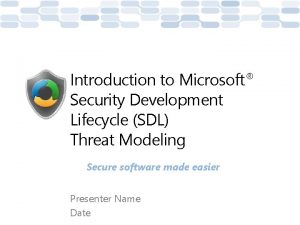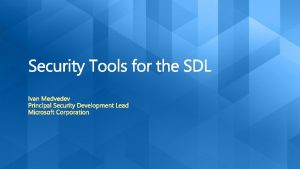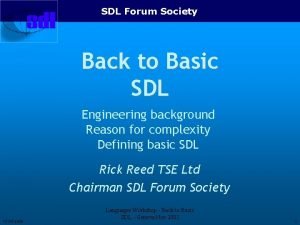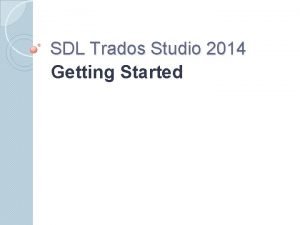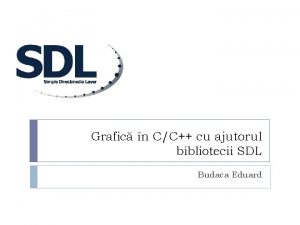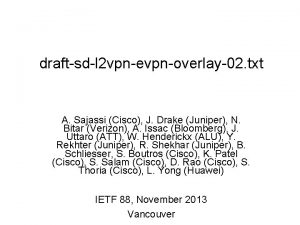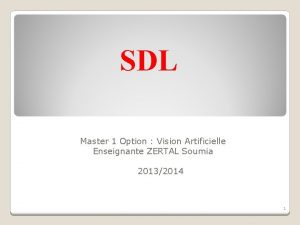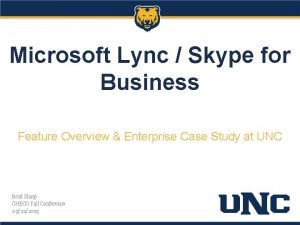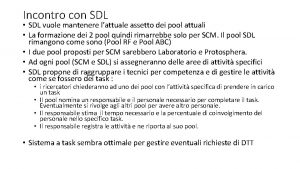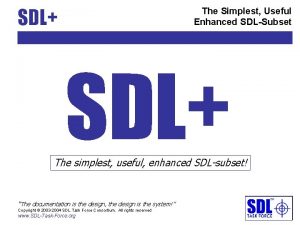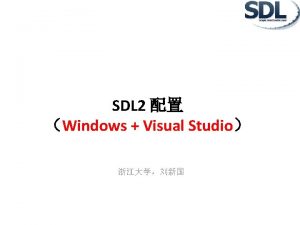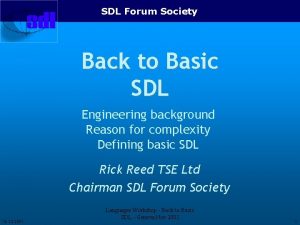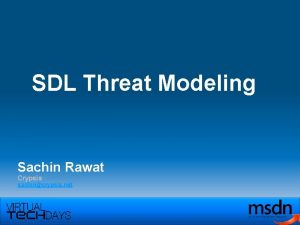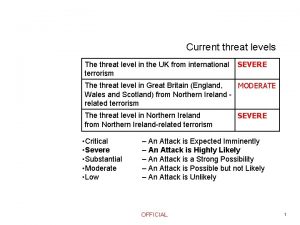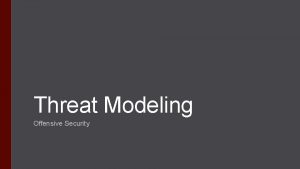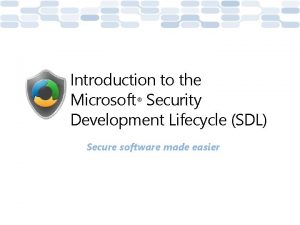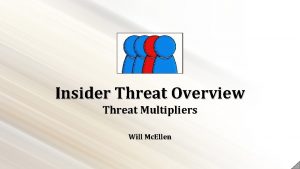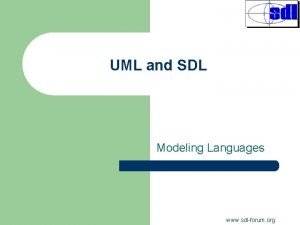Microsoft SDL Threat Modeling Overview Introduction Goals of


































- Slides: 34

Microsoft SDL Threat Modeling ﺍﻣیﺮﺣﺴیﻦ ﻋﻠی ﺍکﺒﺮیﺎﻥ

Overview § § § Introduction Goals of Threat Modeling The approach

Threat Modeling Basics § § § Who? What? When? Why? How?

Who § Building a threat model § § Dev owns DFD (diagram) Test owns ID threats (analyze) PM owns overall process Customers for threat models § § § Your team Other feature, product teams Customers, via user education ‘External’ QA resources like pen testers Security Advisors

What § § Reason about, document and discuss security in a structured way Threat model & document § § The product as a whole The security-relevant features The attack surfaces Assurance that threat modeling has been done well

Why Threat Model § Produce software that’s secure by design § § Improve designs the same way we’ve improved code Because attackers think differently § Creator blindness/new perspective

The Approach In a Nutshell Vision Diagram Identify Threats Validate Mitigate

STRIDE/Element: Vision Diagram Identify Threats Validate Mitigate

Vision § Scenarios § § § Where do you expect the product to be used? XBOX is different from Windows 7 xbox. com is different from XBOX Use cases/Use Stories Add security to scenarios, use cases Assurances/Guarantees § Structured way to think about “what are you telling customers about the product’s security? ”

STRIDE/Element: Diagramming Vision Diagram Identify Threats Validate Mitigate

How to Create Diagrams § § Go to the whiteboard Start with an overview which has: § § § A few external interactors (some use ‘actors’) One or two processes One or two data stores (maybe) Data flows to connect them Check your work § § Can you tell a story without edits? Does it match reality?

Diagramming § Use DFDs (Data Flow Diagrams) § § § Include processes, data stores, data flows Include trust boundaries Diagrams per scenario may be helpful Update diagrams as product changes Enumerate assumptions, dependencies Number everything (if manual)

Diagram Elements - Examples External entity • People • Other systems • Microsoft. com • etc… Process • DLLs • EXEs • Components • Services • Web Services • Assemblies • etc… Trust Boundary • Process boundary • File system Data Flow • Function call • Network traffic • Etc… Data Store • Database • File • Registry • Shared Memory • Queue/Stack • etc…

Diagrams: Trust Boundaries § Add trust boundaries that intersect data flows § Points/surfaces where an attacker can interject § Machine boundaries, privilege boundaries, integrity boundaries are examples of trust boundaries § Threads in a native process are often inside a trust boundary, because they share the same privs, rights, identifiers and access § Processes talking across a network always have a trust boundary

Diagram Iteration § § Iterate over processes, data stores, and see where they need to be broken down How to know it “needs to be broken down? ” § § § More detail is needed to explain security impact of the design Object crosses a trust boundary Words like “sometimes” and “also” indicate you have a combination of things that can be broken out § “Sometimes this datastore is used for X”…probably add a second datastore to the diagram

Diagram layers § Context Diagram § § Level 1 Diagram § § High level; single feature / scenario Level 2 Diagram § § Very high-level; entire component / product / system Low level; detailed sub-components of features Level 3 Diagram § § More detailed Rare to need more layers, except in huge projects or when you’re drawing more trust boundaries

A Real Context Diagram (Castle)

A Real Level-0 DFD (Castle)

STRIDE/Element: Identifying Threats Vision Diagram Identify Threats Validate Mitigate

Understanding the threats Threat Property Definition Example Spoofing Authentication Pretending to be any of billg, xbox. com or a system update Tampering Integrity Impersonating something or someone else. Modifying data or code Repudiation Non-repudiation Claiming to have not performed an action “I didn’t cheat!” Information Confidentiality Exposing information to someone not authorized to see it Deny or degrade service to users Reading key material from an app Gain capabilities without proper authorization Allowing a remote internet user to run commands is the classic example, but running kernel code from lower trust levels is also Eo. P Disclosure Denial of Service Availability Elevation of Privilege Authorization Modifying a game config file on disk, or a packet as it traverses the network Crashing the web site, sending a packet and absorbing seconds of CPU time, or routing packets into a black hole

Different threats affect each type of element External Entity S T R I D E Process Data Store Dataflow ?

Apply STRIDE Threats To Each Element For each thing on the diagram: Apply relevant parts of STRIDE External Entity: SR Process: STRIDE Data Store, Data Flow: TID Data stores which are logs: TID+R Data flow inside a process: Don’t worry about T, I or D Number things so you don’t miss them

A Real Level-0 DFD (Castle) TID TID STRIDE Etc…

STRIDE/Element: Mitigating Vision Diagram Identify Threats Validate Mitigate

Mitigation is the point of threat modeling § Mitigation: § § Protect customers Design secure software Why bother if you: § § To address or alleviate a problem Create a great model Identify lots of threats Stop So find problems and fix them § File bugs to track them

Mitigate § § Address each threat Four ways to address threats: § § § Redesign to eliminate Apply standard mitigations Invent new mitigations § § § Riskier Accept vulnerability in design Address each threat!

Standard Mitigations Spoofing Authentication Tampering Integrity Repudiation Non Repudiation Information Disclosure Confidentiality Denial of Service Availability Elevation of Privilege Authorization To authenticate principals: Basic & Digest authentication Live. ID authentication Cookie authentication Windows authentication (NTLM) Kerberos authentication PKI systems such as SSL/TLS and certificates IPSec Digitally signed packets To authenticate code or data: Digital signatures Message authentication codes Hashes Windows Mandatory Integrity Controls ACLs Digital signatures Message Authentication Codes ACLs Filtering Quotas Authorization High availability designs Strong Authentication Secure logging and auditing Digital Signatures Secure time stamps Trusted third parties Encryption ACLS ACLs Group or role membership Privilege ownership Permissions Input validation

Inventing Mitigations is Hard § § § Mitigations are an area of expertise like networking, databases, or cryptography Amateurs make mistakes, so do pros Mitigation failures will appear to work § § § Until an expert looks at them We hope that expert will work for us When you need to invent mitigations, get expert help § We will try to talk you off the ledge

STRIDE/Element: Validating Vision Model Identify Threats Validate Mitigate

Validating Threat Models § Validate the whole TM § § Does diagram match final code? Are threats enumerated? Minimum: STRIDE per element that touches a trust boundary Has Test reviewed the model? § § § Is each threat mitigated? § § Created appropriate test plans Tester approach often finds issues with TM, or details Are mitigations done right Did you check these before FSR? § Shipping will be more predictable

Validate Quality of Threats & Mitigations § Threats § § Describe the attack Describe the context Describe the impact Mitigations: § § Associate with a threat Describe the mitigation(s) File a bug Fuzzing is a test tactic, not a mitigation

Validate Information Captured § Dependencies § § What other code are you using? What security functions are in that other code? Are you sure? Assumptions § § Things you note as you build the threat model “HTTP. sys will protect us against SQL Injection” “LPC will protect us from malformed messages” Crypt. Gen. Random will give us crypto-strong randomness

Effective Threat Modeling Meetings § § Start with a DFD walkthrough Identify most interesting elements § § Assets (if you identify any) Entry points/trust boundaries Walk through STRIDE against those Threats that cross elements/recur § Consider library, redesigns

 Sdl model
Sdl model Free threat modeling tools
Free threat modeling tools Microsoft threat modeling tool
Microsoft threat modeling tool Strategic goals tactical goals operational goals
Strategic goals tactical goals operational goals Strategic goals tactical goals operational goals
Strategic goals tactical goals operational goals Microsoft sdl
Microsoft sdl Microsoft sdl indianapolis
Microsoft sdl indianapolis Sdl life cycle
Sdl life cycle Web application threat modeling
Web application threat modeling Privilege game
Privilege game Threat modeling
Threat modeling Modeling role modeling theory
Modeling role modeling theory Dimensional modeling vs relational modeling
Dimensional modeling vs relational modeling Sdl first vs code first
Sdl first vs code first Sdl_gpu
Sdl_gpu Sdl forum
Sdl forum Sdl trados studio 2014
Sdl trados studio 2014 Sdl specification and description language
Sdl specification and description language Sdl
Sdl Biblioteca grafica c++
Biblioteca grafica c++ Cisco webex is connected through sdl
Cisco webex is connected through sdl Sdl
Sdl Persdl
Persdl Sdl scaffolding
Sdl scaffolding Dsm ship management
Dsm ship management Sdl vision
Sdl vision Icculus.org
Icculus.org Ufr sdl
Ufr sdl General goals and specific goals
General goals and specific goals Examples of generic goals and product-specific goals
Examples of generic goals and product-specific goals Lync vs skype for business
Lync vs skype for business What is bioinformatics an introduction and overview
What is bioinformatics an introduction and overview Introduction product overview
Introduction product overview Introduction product overview
Introduction product overview Introduction product overview
Introduction product overview





